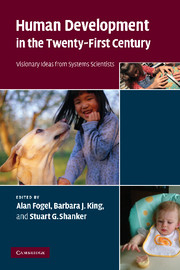Book contents
- Frontmatter
- Contents
- List of contributors
- Introduction: Why a dynamic systems approach to fostering human development?
- Part I Dynamic relationships between genetics and environments
- 1 Developmental dynamics: the new view from the life sciences
- 2 Genes, experience, and behavior
- 3 How dynamic systems have changed our minds
- 4 Individual development as a system of coactions: implications for research and policy
- 5 Gene–environment interactions and inter-individual differences in rhesus monkey behavioral and biological development
- Part II The dynamic system of the child in the family
- Part III The dynamic system of the child in social and physical environment
- Part IV Dynamic systems approaches to mental health
- Part V Conclusions and outlook
- Index
- References
1 - Developmental dynamics: the new view from the life sciences
Published online by Cambridge University Press: 22 September 2009
- Frontmatter
- Contents
- List of contributors
- Introduction: Why a dynamic systems approach to fostering human development?
- Part I Dynamic relationships between genetics and environments
- 1 Developmental dynamics: the new view from the life sciences
- 2 Genes, experience, and behavior
- 3 How dynamic systems have changed our minds
- 4 Individual development as a system of coactions: implications for research and policy
- 5 Gene–environment interactions and inter-individual differences in rhesus monkey behavioral and biological development
- Part II The dynamic system of the child in the family
- Part III The dynamic system of the child in social and physical environment
- Part IV Dynamic systems approaches to mental health
- Part V Conclusions and outlook
- Index
- References
Summary
James is an eleven-year-old boy who is tall for his age, has blond hair and blue eyes, loves to play baseball, and is the best right-handed pitcher on his little league team. James is easy going, popular among his classmates at school, and excels in math and science classes. What is the source of such traits as athletic ability, temperament, and intelligence? Why are some children outgoing and socially skilled, while others appear introverted and avoid unfamiliar social situations? Why do some children find puzzles of logic interesting and challenging, while others don’t seem interested or willing to apply themselves to such mental tasks?
In the first half of the twentieth century, many biologists and psychologists thought that major aspects of behavioral development progressed in an orderly and preordained sequence under the direct control of genes. From this view, genes were seen to guide the nervous system to mature in a predetermined fashion, giving rise to so-called “innate” or “instinctive” behavior. Likewise, human characteristics like temperament, intelligence, or athletic ability were thought to be genetically based and to be relatively unaffected by experience or environment. Thanks in large part to more than half a century of comparative and developmental research, most biologists and psychologists now appreciate that behavior does not simply unfold from some predetermined genetic blueprint or template. Assumptions of genetically determined “innate” or “hard-wired” behavior have gradually given way to the realization that genes cannot, in and of themselves, produce behavioral or psychological traits or characteristics.
- Type
- Chapter
- Information
- Human Development in the Twenty-First CenturyVisionary Ideas from Systems Scientists, pp. 11 - 17Publisher: Cambridge University PressPrint publication year: 2007
References
- 1
- Cited by

